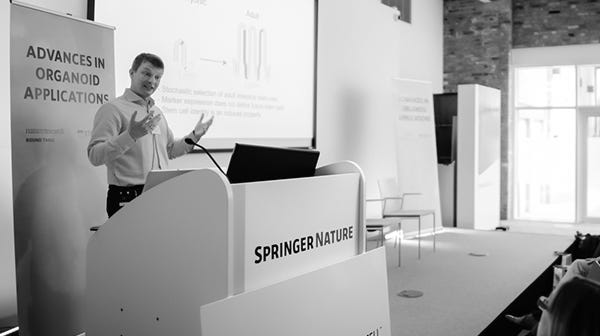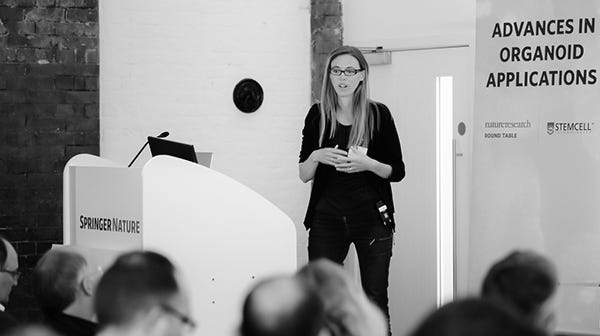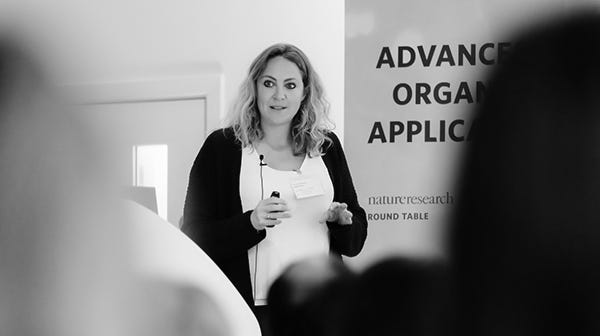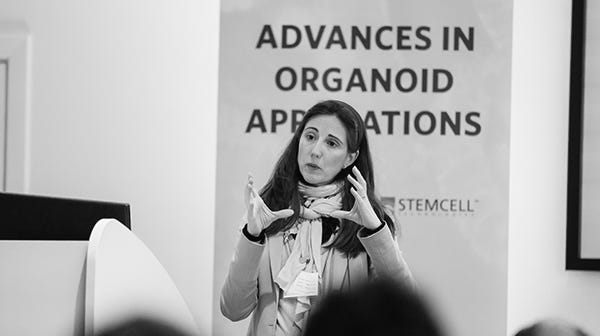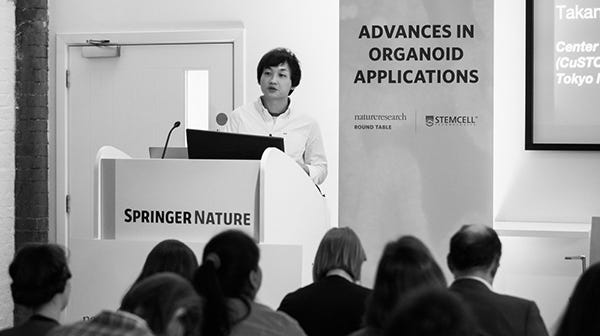Organoids: Experts Talk Standardization at Nature Research Round Table
"The exciting thing is to actually work on real cells"
LONDON, UK - Organoids will revolutionize precision diagnostic approaches and future drug development. This prediction was a recurring theme throughout the “Advances in Organoid Applications” Round Table event co-organized by Nature Research and STEMCELL Technologies. Consensus-building among leaders of the field and researchers gathered was a key driver for the one-day event in June, 2019. Core discussions centered around protocol standardization, translation into patient care, nomenclature, and understanding what questions a given organoid culture can and can’t answer.

Prisca Liberali, Madeline Lancaster, and Kim Jensen during the first panel discussion of the day.
A New Research Approach
For years, Dr. James Goldenring relied on transformed cell lines to answer his research questions. Now, he uses organoids extensively in concert with in vivo models. “The exciting thing is to actually work on real cells,” he said after presenting his research on pediatric diarrhea. For Goldenring and countless other researchers, organoids offer an additional research approach, one that often brings them closer to the in vivo state. As a result, we are now closer to answering fundamental research questions about how cells perform critical tasks, such as transmembrane cargo transport that Goldenring studies. Ultimately, this approach could lead to the development of preventative measures for life-threatening conditions such as pediatric diarrhea.

Dr. Hans Clevers set the stage for the day with an introduction on ‘Organoids as models for human disease’. A pioneer in the development of organoid technologies, his work had served as both inspiration and foundation for most researchers in the room.

When I first saw the beautiful paper from Hans Clevers back in 2009, I knew I had to get my hands on the epithelium from the intestine to see how robust this method was.
Dr. Kim Jensen on first hearing about organoids.
“When I first saw the beautiful paper from Hans Clevers back in 2009, I knew I had to get my hands on the epithelium from the intestine to see how robust this method was,” said Dr. Kim Jensen in an interview. Jensen, Dr. Madeline Lancaster, and Dr. Prisca Liberali all presented their work on developing organoid models to study physiological development during the first themed talks of the day. In an interview after her talk, Liberali said “Right now, I think it is a perfect system where we can look to a single cell and see how it grows into a fully formed organoid in a few days.” This, combined with their ability to retain the cellular programming of the cells involved, is what makes organoids a truly revolutionary technology for biomedical research.
What Is Being Modeled in Organoid Culture Systems?
Organoids have been shown to largely recapitulate the morphology and cellular behavior of their in vivo counterparts. This in vivo-like cellular programming reduces (but does not eliminate) artifacts that arise when scientists aim to recreate complex biological systems in vitro that they don’t fully understand. Therefore, panel members were unanimous that it is increasingly important to know what it is that is being modeled in our culture systems.

It’s naive to think that you can mix two things together and have a complex system that is more representative. It needs to be done intelligently.
Dr. Mathew Garnett on organoid co-cultures and model complexity.
As organoids become more prevalent, researchers are attempting to increase their complexity even further via cocultures, physical patterning, etc. in hopes of bringing organoids closer to the in vivo state. But what is the balance between using a simple system and a more complicated system? During panel discussions, Dr. Mathew Garnett voiced his concerns with overhyping the complex systems and urged the room to use the lowest degree of complexity to adequately address the research question at hand. “It’s naive to think that you can mix two things together and have a complex system that is more representative. It needs to be done intelligently,” Garnett continued.
The implications of imperfect experimental design on model relevance is a big unknown when scientists seek to control biological interactions. Dr. Juergen Knoblich shared his experience in studying the human brain with organoids. Working with brain organoids, neuroscientists like himself now have a model that far exceeds the relevance of 2D cell cultures or rodent neural models. This is because the cellular layering that spontaneously emerges in organoids mimics the developing human brain much more closely than other models. Their greater complexity therefore adds real meaning. But to Garnett’s point, this complexity arises from the cellular programming, rather than the scientist’s design.

Dr. Meritxell Huch and Dr. James Goldenring present on their work using organoids to study liver disease and pediatric diarrhea, respectively.
Perhaps the most divisive debate of the day was centered around what types of conclusions can actually be drawn from in vitro experiments with organoids.
When organoids are dissociated to single cells and these cells are seeded into new organoid assays, are we truly modeling tissue regeneration? Jensen pointed out that, in vivo, cellular proliferation is balanced with cell death, thus maintaining homeostasis. But whether this state can be accurately represented in rapidly expanding cultures, such as organoids, was questioned. Clevers noted how remarkable it is that the cells in organoid cultures can be maintained in vitro for years without being exhausted in what may be hyperproliferative state. But he stressed not to draw conclusions from organoid cultures alone; these in vitro experiments and hypotheses must also be tested in vivo. To date, many unexpected findings in organoids have pointed the way to new biological discoveries in vivo, underscoring the experimental utility of organoids.
How Do You Define an Organoid?
With increasing ubiquity of organoid technologies comes a need for standardization. Defining what is and what is not an organoid may be the place to start.
“In my view, organoids have to represent the architecture of the target tissue, they have to contain the cell types of the tissue that they are supposed to simulate, some aspects of the physiology, and they have to have some sort of self-organization in their generation,” says Knoblich who is known to favor clearly defined nomenclature. It’s not just semantics—pioneers in the field have seen the word ‘organoid’ used far and wide to take advantage of its popularity. And now, as the word is becoming a ‘must-use’ term on grant applications, its misuse can cause confusion. The abstract of a paper may state that “organoids” are being used, but the Materials and Methods section may reveal a culture system far outside of Knoblich’s generally accepted definition. There was agreement around the room that more stringent enforcement of the definition of “organoid” in abstracts and introductions would increase scientific clarity.
Moving Towards Standardization
Standardization was on everyone’s mind during panel discussions—although there was no consensus on the level of standardization needed. “Sometimes standardization is important, but it can also be constraining on what you can learn if you can’t play around with your culture conditions,” Lancaster noted. In fact, Lancaster and Knoblich’s discovery of brain organoids was unexpected and might not have occurred in a more restrictive environment.

Sometimes standardization is important, but it can also be constraining on what you can learn if you can’t play around with your culture conditions.
Dr. Madeline Lancaster on standardizing culture conditions.
There was little disagreement that experimental reproducibility both within and across labs is a challenge. Protocol variability and batch-to-batch consistency of experimental materials were both acknowledged to be factors limiting the ability of researchers to compare experimental results. Clevers noted the field’s heavy reliance on complex protocols, and Garnett registered his concern that “all you need is a student to add one quarter of the concentration of EGF to their [cancer-derived organoid] culture and a few months later they are working with a totally different culture to the post-doc next to them.” Clevers questioned whether a mechanism within the community to have a database for comparisons could be created. To this end, Nature Research has recently updated Protocols Exchange in a move to provide researchers a platform to interact, chat, and comment on protocols included in publications. This will hopefully increase transparency and clarity compared to traditional Materials and Methods sections. The panel members agreed that improving standardization is an important move towards bringing the technology closer to the clinic.
How Do Organoids Fit into the Clinical Landscape?
Not ten years after their first publication, organoids had already saved a life. In Holland, rectal organoids were grown from a patient, Fabian, who has cystic fibrosis (CF). Because his CF is caused by an extremely rare mutation, no data existed to suggest he would respond to the treatment. The drug’s hefty price tag requires such evidence before Dutch insurers will cover it and therefore there were no treatment options for Fabian.
Enter organoids: researchers were able to show that Fabian’s rectal organoids did indeed respond to the treatment, and as a result, the insurance companies covered Fabian’s treatment and today Fabian is alive and well. This approach was piloted by Clevers and the HUB (Hubrecht Organoid Technology) and is now being implemented elsewhere in Europe. During panel discussions, participants were enthusiastic to hear more about Clevers’ approach and how strenuous the regulatory approval process was. Clevers emphasized that the barrier for approval was much lower because there were no other treatment options for this patient.
This is where organoids can make a real immediate impact, in the treatment of rare diseases. For diseases such as cancer where there is a well-established standard of care, it will take some time for organoids to directly inform treatment options for patients. “Observational trials are ongoing,” Clevers commented, “but it will be years before the statistical evidence is strong enough to suggest a change.” But because cancer cell lines are notoriously difficult to establish, and non-existent for many cancers, organoids have introduced a whole new way to study the disease.

Dr. Mathew Garnett and Dr. Calvin Kuo present on their work using organoids to increase our understanding of cancer biology.
“I'm in the cancer field and I think we're just really starting to see [organoids] enter into the mainstream and that there'll probably be a huge expansion over the next few years,” says Garnett, who presented his work on using organoids for precision cancer therapeutics. Garnett is part of a collaborative effort to establish and bank well-documented organoid lines that can then be made available to researchers worldwide. His group has been at the forefront in investigating how well these organoid cultures represent the sampled tumors, and how this changes over time. “We know that the point of derivation is where there is the largest selective pressure,” Garnett noted. Dr. Calvin Kuo noted that most people consider a period of about 4 - 6 weeks sufficient to scale up enough organoids to screen for drug response, but that this needs to be much shorter to have a meaningful impact on the patient. Garnett emphasized that using simple read-outs and an approach of patient stratification within classes of drugs, rather than individual therapies, could increase the diagnostic value of organoids for cancer patients.
How do organoids fit into the clinical landscape moving forward? One of the attendees, pediatric clinician Dr. Dasja Pajkrt, pleaded for the researchers gathered to push forward ideas that could make an impact in patient’s lives. Dr. Takanori Takebe stressed the need for a specific effort to help drive adoption of organoids at appropriate stages of the drug development process. While Takebe emphasized the value of organoids for this process, he also acknowledged that throughput is an area where organoids cannot approach the efficiency of other, more established systems. “For efficacy,” Takebe hypothesized, “organoids might be serving us tertiarily, or secondarily,” whereas there may grow to be a more primary dependance on organoid cultures for lead optimization for some pharmaceutical programs.
Dr. Geraldine Hamilton, President and CSO of Emulate Bio, noted that for toxicity studies, organoids can enable in vitro results for human toxicity, a stage of costly attrition in the drug development process. Panelists agreed that the FDA, EDA, and major pharmaceutical companies have shown a great deal of interest in organoid technologies, but that there needs to be some input to supplant the drug testing paradigms that have been in place for decades.

Organoids are still underdeveloped compared to more standard medical practice. We need to think about how we can standardize, how can we reproduce the results: those kinds of variability questions need to be addressed before we can progress to real world medical applications.
Dr. Takanori Takebe on next steps for practical organoid adoption.
Takebe suggested the utility of a “bridge entity” that could represent the needs of multiple pharmaceutical companies to conduct validation studies. This data could be used to work with regulatory bodies to support the case for using organoids in some aspects of safety analysis. Hamilton emphasized the need to pair in vitro trials with clinical trials so that the value of organoid-derived data in a clinical setting is obvious. Overall, this interest will magnify when organoids have been properly validated, especially for toxicity assays. “Organoids are still underdeveloped compared to more standard medical practice. We need to think about how we can standardize, how can we reproduce the results: those kinds of variability questions need to be addressed before we can progress to real-world medical applications,” said Takebe.
Organoids have lived up to the hype. You’d be hard pressed to find a scientific discovery that reached wide adoption as quickly as the organoid technology did—organoids went from discovery to clinical application in a single decade. Since Clever’s original publication, organoids have been used to inform everything from fundamental developmental biology to individual patient care decisions. They’ve been used to accelerate efforts for engineered tissue manufacture, and for some fields of study, such as neuroscience, pluripotent stem cells and organoids have provided unprecedented access.
“There is just no other way to study the function of the human brain and to do genetics on human brain tissue,” Knoblich said. He added that many pharmaceutical companies had suspended their neural programs at the beginning of the 21st century, but now that there are new avenues to study neurological disease, companies have re-invested in the space. “It’s never been more exciting than now,” Knoblich beamed.

